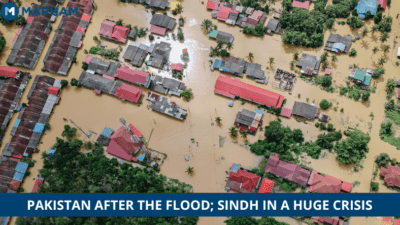The monsoon is celebrated in Karachi and welcomed with song and dance, immortalized in poetry, and depicted in romantic fantasy.
Even the meal is festive for the season: in the cities, deep-fried veggies in chickpea flour batter; grilled corn on the cob; stir-fried mushrooms with fenugreek; spiced slow-cooked lotus roots; and mangoes everywhere.
Sources reports that the monsoon rains are a lifeline for rural Pakistan. However, they brought disease, death, and destruction this year.
When rivers, canals, and lakes overflowed due to the severe rains, entire villages were destroyed, highways were submerged, millions of acres of crops were destroyed, and millions of people were left homeless.
The rain was so intense and continuous that we ran out of adjectives to describe it, including epic, biblical, and apocalyptic.
We run out of understandable numbers to describe the situation:
“15 inches of rain in one day, 44,000 square miles of land inundated, cities, residences, and schools covered by two fathoms of water, approximately 1,700 fatalities, and 33 million people affected”- National Weather Forecasting Centre
And now, after a brief period of global interest, we are losing people’s interest.
The breathtaking pictures of people and animals being rescued from drowning and individuals running from their homes while carrying bundles of belongings on their heads are in the past.
The threatening churning and ferocious water velocity had subsided. Due to the Indus River’s journey to the sea, the low-lying southeasterly province of Sindh served as a natural drainage system for the nation.
The Indus, however, continued to experience heavy floods for more than a month, and even when it partially recovered its capacity, many flooded districts were located far away and were unable to discharge anywhere.
The filthy rainfall, which continues to cover millions of square miles, is standing with a killing calm and a vicious quiet.
Cholera and gastroenteritis are two common waterborne illnesses that plague the populace. Malaria and dengue fever are spread by the billions of mosquitoes that have reproduced.
News report that since June, hundreds of kids have passed away. More than 370,000 people are currently residing in hurriedly constructed camps in Sindh alone.
Volunteers claim that 50% of those living in these tent communities are gravely ill. There is a shortage of both doctors and medications.
Some of Sindh’s inundated areas are kilometers from any outlet where the water could be drained.
Despite the urgent necessity, Pakistan’s government lacks the equipment and technical know-how to remove the water.
Apart from all these things, Marham is giving services of best medical facilities in these tough times to help the public of Pakistan.

